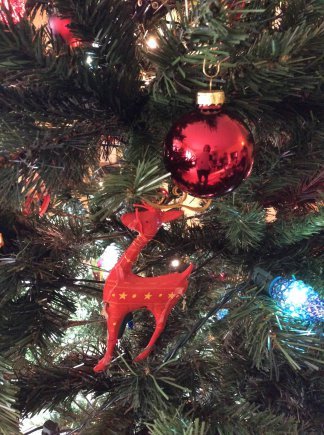The advent season and Christmas time in Germany is magical. Typical German seasonal customs — the romantic historical markets, the tasteful decorations of the cities with garlands, lights and glittering Christmas trees — make the darkest time of the year shine bright.
People decorate their houses with wreaths, put lighted candles and pyramids in their windows, and decorate their yards with lights.
The official start of the holiday season for Germans is on the first of four Advent Sundays. Families gather around a decorated wreath with four candles, called “Adventskranz,” and light a new candle every Sunday until all four are burning. The afternoons are an opportunity to enjoy an “Adventskaffee” (coffee) with cake or home-baked “Weihnachtsplätzchen” (Christmas cookies). The children have Advent calendars that are filled with sweets or small gifts to open each day until December 24 to make the waiting period seem shorter.
It is also the season to enjoy social time with family and friends. As the weather turns colder, parents spend time with their children indoors baking cookies or creating decorations for windows and trees. Co-workers sometimes visit a local Christmas market together after work to enjoy a cup of “Glühwein” or hot chocolate.
An old and almost forgotten tradition is cutting a few branches of fruit and nut trees, like apple, cherry or chestnut trees Dec. 4 and putting them in a vase filled with water. December 4 is Barbaratag, named after the martyr St. Barbara, who died in the third century. If all goes right, the branches will bloom by Christmas Eve, not only bringing color and fragrance into the house, but also serving as a good-luck charm for the coming year.
The children look forward to a visit by St. Nikolaus in early December; the saint usually appears in the Eastern Rite vestments of a bishop, and carries a ceremonial staff. He stops by the homes of children on the eve of Dec. 6 and places oranges, nuts, candy and sometimes small presents into the shined boots they have placed outside. Sometimes Nikolaus comes into the homes or Kindergartens to talk to the children and listen to their recitals of songs and poems. Often he is accompanied by his assistant, Knecht Rupprecht, a mean-looking fellow who threatens to punish naughty children by taking them away in his potato sack. In the Alpine regions, St. Nikolaus is often accompanied by a scary looking hairy figure called Krampus.
A Christmas tree is an important decoration detail for most homes in Germany. The trees are sold on the street corners or supermarket parking lots and carried home on the tops of cars. Families often pick out trees together. The tradition of the Christmas tree dates back to the 15th century. At first the tree was decorated only with apples, nuts and sweets; wax candles were added later. Many German families still decorate their tree in the “altdeutsche Tradition,” or the old German way, with real candles and wood and straw ornaments. The tree stays up usually until after New Year’s or even until Jan. 6, Three Kings Day.
Christmas Eve is usually spent with close family and includes attending a festive church service together; each family has their own traditions, which sometimes include the joint singing of Christmas songs or children performing on their musical instruments. Some families prepare a special meal, the recipe handed down through the generations; some keep it very simple with “Würstchen und Kartoffelsalat” (wieners and potato salad); others serve fish or poultry.
The highlight of the evening is, especially for the children, the opening of the presents. The delivery person for the presents varies by region. In the south of Germany — as well as Austria and Switzerland — the packages are often brought by the “Christkind” (Christ Child) and assistant angels. In the north the job usually keeps the Weihnachtsmann busy, a guy in a red suit who looks a lot like the American Santa Claus. To make sure the children can’t watch when the packages are put under the tree, the parents lock the room with the Christmas tree until a little bell rings and the children are allowed inside.
Christmas Day is reserved for a large festive meal and time spent with the extended family. The day after Christmas, Stefanstag, is also an official holiday, often used as an opportunity for more visits with family and friends, or long walks in the crisp winter air.
The holiday season comes to an end Jan. 6, another German holiday known as “Dreikönigstag” (Three Kings Day or Epiphany). Around this time, the “Sternsinger” (star singers), members of the local church communities, walk from door to door to collect money for charity projects. The group is usually composed of four children or teenagers, dressed up as the three wise men and a star bearer. After singing a song or reciting a poem or prayer, they write the annual blessing on the front door with a piece of chalk: 20 C+M+B 17 — “Christus mansionem benedicat,” wishing you the best for the new year and “May Christ Bless this House.”

